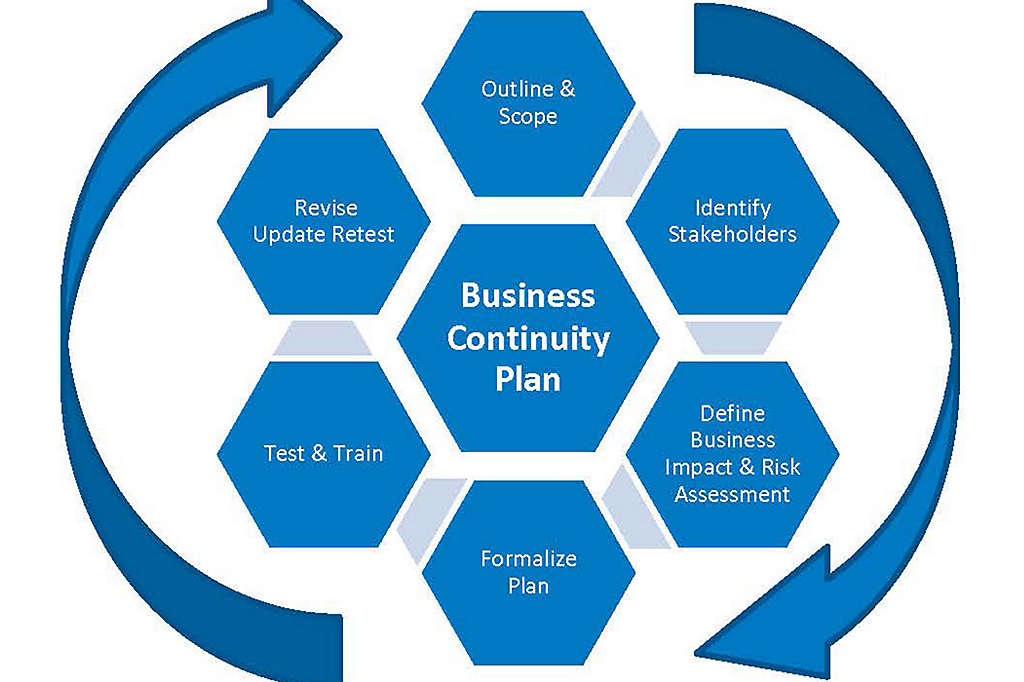Emergency Readiness
Prepare your business for possible disruptions with a business continuity plan
There is a series of business processes that can be overlooked when running a day-to-day business. But the need for those processes becomes apparent in situations where we face the unexpected. This is where a business continuity plan (BCP) comes in. It can help protect your business against potential disruptions.

In developing or updating your BCP, you will outline the process, steps, team, and resources involved to maintain core business operations during troubling times. Your plan can be simple or complex, depending on the nature, size, and breadth of your business and what level of preparedness you want to have.
What is a business continuity plan (BCP)?
A BCP is a document that contains vital information an organization needs to continue to operate during a crisis, including natural disasters. It identifies and details which systems and processes need sustaining and maintaining during an unplanned event. The aim of a BCP is to minimize revenue or reputation loss.
How to create a business continuity plan:
1. Define scope
Start by deciding which processes are critical and which are desirable. This will help determine the scope of the plan. The types and number of essential processes will drive depth, complexity, time investment, and cost.
2. Identify and engage stakeholders
Typically, businesses will develop a planning committee made up of senior leaders, a BCP coordinator, and other key representatives from various parts of the business.
3. Evaluate impact and assess risks
A Business Impact Analysis (BIA) will forecast the potential impact a disruption event may have on the business. This analysis can highlight both short-term and long-term impacts, and areas of strength and weakness in the organization. Local risk information can be attained through a Hazard Vulnerability Assessment (HVA) available through the local emergency management agency. With this information, a Risk Assessment (RA) can be done to help identify and prioritize larger and smaller risks.
4. Construct a BCP strategy
The Business Impact Analysis, Hazard Vulnerability Assessment, and Risk Assessment will help shape your Business Continuity Strategy. Some important components of the plan include remote connectivity, alternative site options, interim procedures, systems restoration, business backlog management, communication strategies, and the tracking of metrics.
5. Develop a communication plan
In the event of a business disruption, a clear communication strategy for advising all stakeholders, including management, staff, and vendors, as well as media and the community, is critical. A good strategy covers issues such as what medium should be leveraged, who owns the messaging, and how to defer inquiries to the right teams to limit miscommunications and inconsistencies.
6. Include details critical to the plan
An appendix section should include information about key customers, vendors, supplies, forms, websites, reports, and anything else that might be needed to support the plan.
7. Test your plan periodically and conduct training
Performing regular walk-throughs with staff improves understanding of the plan directives and identifies areas of weakness that need to be addressed.
8. Do you have business continuation insurance?
If so, is it an adequate amount? Business continuation insurance can cover losses if a key executive or business owner becomes disabled or passes away. The funds can help minimize business disruption and help you continue operations.
9. Revise and update
Staff, business dynamics, and objectives change. It is recommended that businesses have a quarterly review of the plan and a comprehensive review annually.
Keys to success in BCP planning and execution
There are several requirements that are essential to success:
- Maintain your focus on a BCP and emphasize its importance to your stakeholders and staff. The COVID-19 pandemic is an extreme case of business interruption. However, business interruptions, like utility failures, weather events, and systems breakdowns are much more common. Being ready for a disruption event, even a minor one, can make a big difference in retaining staff and customers, and even in ensuring the survival of the business.
- Don’t let the perfect be the enemy of the good. Some planning is better than none. Businesses with no plan can be devastated by even a relatively minor disruption event. Establishing a base level plan is a great first step and can be improved upon over time. It is always better to have some level of planning versus no planning at all.
- Leverage all available resources. The development of a BCP is a collaborative process that will involve key people from within and outside of the organization. Attorneys, insurance agents, accountants, local business associations, online vendors, and government emergency groups can all assist.
All the above points are best practices in devising a strong BCP, which is essential to the long-term health of any business. As you devise your plan, keep in mind that you are not alone. Numerous resources are available to help you along your BCP path. Below, we list organizations that can help you as you devise and update your BCP plans.
Helpful organizations
- National Fire Protection Association (NFPA): Standard on Disaster/Emergency Management and Business Continuity /Continuity of Operations Programs (www.nfpa.org)
- DRI International: Professional Practices for Business Continuity Management (www.drii.org)
- Federal Emergency Management Organization (FEMA): Continuity Guidance for Non-Federal Entities (www.fema.gov)
- Insurance Institute for Business Home and Safety: Open for Business (OFB-EZ®) continuity toolkit (www.disastersafety.org)
- Business Continuity Templates: (www.smartsheet.com)
- American Red Cross: Developing your emergency action plan (www.readyrating.org)
This writing is provided for informational purposes only. New York Life Insurance Company, its agents, and employees may not provide tax, legal, or accounting advice, and none is intended nor should be inferred from the foregoing comments and observations. Clients should consult their own tax, accounting, and legal advisors, who must form their own independent opinions on these matters based upon independent knowledge and research. © 2024 New York Life Insurance Company. All rights reserved.




